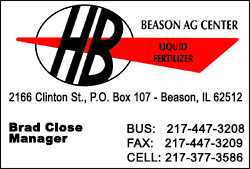|
 Trust is a tricky item to manage. It is a
commodity you can never have too much of. It is a value that can be
damaged easily and can be irreparable. You canít buy trust, you have
to earn it. You canít control whether someone will trust you, but
you can certainly influence it. You can damage or destroy your trust
relationship with one word misspoken to an unrelated third party.
And your entire future is built on your treasure trove of trust. Trust is a tricky item to manage. It is a
commodity you can never have too much of. It is a value that can be
damaged easily and can be irreparable. You canít buy trust, you have
to earn it. You canít control whether someone will trust you, but
you can certainly influence it. You can damage or destroy your trust
relationship with one word misspoken to an unrelated third party.
And your entire future is built on your treasure trove of trust.
In order to approach your farm lender, todayís farmer needs to
really understand five critical things. These things will convey to
your lender that you have the necessary knowledge, procedures, and
focus in place. Without these critical things, trust will not grow
and the relationship will not deepen. What is at risk - everything!

The first area of a lenderís focus includes three management
elements: risk management, marketing plan and business plan. The
definition of business (and farming is indeed a business) is to take
a measured risk to bring about a measured positive outcome. This
process is called risk management. Risk can never be left to manage
itself because the result is usually failure. Risk must be
quantitatively weighed and balanced with known guarantees. The
outcome must be calculated beforehand, and is backed by faith and
personal endorsement.
It isnít enough to have the materials, expertise, and equipment to
produce a product. You must balance your ability to produce with
your plan to trade your product for MONEY. Your marketing plan must
factor in what quality your final product will be and what return
you will receive for it. It needs to have details about who will buy
your product, and what your plan B will be if your plan A falls
through.
Your business plan needs to tie together your risk management plan,
your marketing plan and all the details about your operation, and
show a predictable outcome. It needs to predict what will happen
over the next five years, anticipate various risks and detail in
advance what you plan to do about them.
These three elements need to be written documents for two reasons:
1) They need to be your written word that this is the path you
intend to follow (a guarantee of sorts) and 2) They need to
communicate your plan in detail to both you and your farm lender.
These documents, depending on your plan, intensity, and clarity -
will earn you trust. There are templates and examples of these
documents are available on the internet.

The second area of focus is to keep excellent bookkeeping and be
able to present your lender with a periodic accrual income statement
of earnings. It is necessary to keep accrual books rather than cash
books because you have an inventory that you manage.
Your accrual statement of earnings needs to detail all the cash
transactions that you have made, plus detail all your accounts
payable, all the loans you manage, all the income you have (cash)
and are owed, and all the inventory you have to sell and its value.
Your statement of earnings needs to be a concise and accurate
snapshot of your operation at a given moment. Your lender acutely
understands the condition of your entire enterprise by the
information you present in your accrual income statement of
earnings, and will be able to recognize any deviation from reality
in this report with eagle eyes.
The third area of focus is another area of bookkeeping which
involves asset and debt management. There are five elements in this
area.
The first two elements, current ratio debt to
asset ratio, and leverage ratio, convey to your lender how much skin
you have in the game and your balance of owned value to owed debt.
- Debt to asset ratio, the target in all lending is 80% or less;
meaning that the lender is very unlikely to lend on the purchase of
land, equipment, buildings or inputs if you cannot come up with a
sizable investment in those items.
- Leverage ratio considers all the assets of your
operation Ė the ratio between what is owned versus what is purchased
on credit - and determines what level of your total owned operation
is leveraged against your debt.
A lenderís primary concern will be the security of their investment,
and secondarily, the success of your operation. Security and success
are tightly tied together with the final three elements: loan to
value, shock test and burn factor.
[to top of second column] |

- Wikipedia defines your loan-to-value (LTV) ratio as the ratio of a
loan to the value of an asset purchased. The term is commonly used
to represent the ratio of the first mortgage line as a percentage of
the total appraised value of real property.
For instance, if someone borrows $130,000 to purchase a house worth
$150,000, the LTV ratio is $130,000 to $150,000 or
$130,000/$150,000, or 87%. The remaining 13% represent the lender's
ďhaircutĒ (a haircut is the difference between the market value of
an asset used as loan collateral and the amount of the loan. The
amount of the haircut reflects the lender's perceived risk of loss),
adding up to 100% and being covered from the borrower's equity. The
higher the LTV ratio, the riskier the loan is for a lender.
- Financial shock tests are designed to visualize your cash flow
through your production season. They are designed to determine if
you will have the resources necessary to meet the needs of your
operation (and your family) and the cost of your indebtedness. Shock
tests may have an impact on your business plan, your marketing plan,
and your plans to buy new equipment, land, or buildings.
- An element related to shock tests is ďburn factor,Ē the rate at
which a company uses up its supply of cash over time. Lenders will
be especially cautious around producers with high cash burn rates.
These investments can turn to ashes.

The fourth area of a lenderís focus will be determining your level
of financial management ability. A producer who has a low level of
managing finances and bookkeeping and does not hire the necessary
help will not be able to anticipate trends or strategize clearly.
Taking classes on farm financial management and hiring expert in
financial help will spell out whether your lender should extend your
indebtedness.
The final area of a lenderís focus will be to measure who worries
about your loans and financial position, you or your lender. This is
a measurement of your attitude and confidence.
If you convey to your lender that you are not worried or concerned
about your business plan and your indebtedness, that conveys a
signal to your lender that you are over-confident or falsely
confident in your plans and your position. The picture of risk
management you convey and your level of surety must include a
healthy dose of anxiety about the possible outcomes for yourself and
your lender.
The first bit of trust you get will be a gift. That gift will be
that you get to make your best presentation to the people you hope
will be your lenders. The rest of the trust you get will be earned.
Understanding that these focus areas are at the forefront of your
lenderís mind will help you prepare, present, and succeed.
-----
Adapted from ďA Lenders Focus in Agriculture TodayĒ
by Rich Ritter 2017.

|